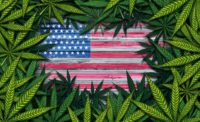CANNABIS PRODUCTS -- FALL 2018
Cannabis: A New Frontier for Food Product Developers
Legal cannabis edibles and beverages present a wealth of opportunity for innovative product development

Three decades ago, in 1996, legal cannabis started its nascent journey when California approved its use to treat medical conditions. Today, it has grown into a rapidly expanding industry offering potentially lucrative new market development, with the majority of U.S. states—red and blue alike—supporting some level medical and/or recreational cannabis use.
Arcview Market Research and BDS Analytics predict that combined medical and recreational legal cannabis sales in the U.S. will top $11 billion in 2018. And according to the 2017 “Marijuana Business Factbook” from Marijuana Business Daily, by 2021 U.S. sales are anticipated to top $17 billion.
This rapid rate of growth isn’t confined to the U.S. As of October 17, 2018, Canada has fully legalized medical and recreational use. Nearly 30 countries around the world have legalized cannabis in some form. Euromonitor has estimated that the total global legal cannabis market will exceed $50 billion by 2025.
The legal cannabis industry is growing increasingly mainstream, and infused products and edibles are its fastest-growing segment.
Substantive research
The ongoing federal Schedule I classification of cannabis has notably curtailed medical and health-focused research in the U.S. Nevertheless, initial findings show great promise.
As reported by the National Academy of Sciences (NAS) in January 2017 in “The Health Effects of Cannabis and Cannabinoids: The Current State of Evidence and Recommendations for Research” (see http://nationalacademies.org/hmd/reports/2017/health-effects-of-cannabis-and-cannabinoids.aspx), research has discovered evidence supporting medical use of cannabis.
According to NAS, conclusive or substantial evidence exists that cannabis or cannabinoids are effective for:
- The treatment for chronic pain
- The treatment of chemotherapy-induced nausea and vomiting
- Improving multiple sclerosis spasticity symptoms
NAS also notes moderate evidence exists for using cannabis or cannabinoids to improve short-term sleep outcomes in individuals with sleep disturbance associated with obstructive sleep apnea syndrome, fibromyalgia, chronic pain and multiple sclerosis.
Finally, NAS reports that limited evidence exists that cannabis or cannabinoids are effective for:
- Increasing appetite and decreasing weight loss associated with HIV/AIDS
- Improving clinician-measured multiple sclerosis spasticity symptoms
- Improving symptoms of Tourette syndrome
- Improving anxiety symptoms in individuals with social anxiety disorders
- Improving symptoms of post-traumatic stress disorder
Use of cannabis for controlling seizures is also well-documented. In June 2018, FDA approved its first cannabis-derived drug, Epidiolex, to minimize incidence of seizures related to epilepsy. The drug features cannabidiol (CBD), a non-psychoactive cannabinoid. Subsequently, FDA rescheduled FDA-approved drugs that contain CBD and less than 0.1 percent tetrahydrocannabinol (THC).
These developments will likely open the door to more research to verify additional medical uses for cannabis and cannabinoids.
CBD growth
“The market potential for CBD-only products is massive,” says Justin Singer, CEO and co-founder, Stillwater Foods, Denver. “If you look at the market sizes of functional ingredients like omega-3s, probiotics and flavanols, I think those are reasonable proxies for CBD’s potential. This is a safe—according to the World Health Organization—non-psychoactive compound with a rapidly growing corpus of research testifying to its benefits across a range of areas. In a way, CBD is everything turmeric/curcumin wants to be, and more.”
While small- to medium-scale upstart companies have fueled much of this industry’s growth in the U.S. to date, that situation is poised to change. When mainstream industry giants like Coca-Cola Co. note that they are looking to get into development of CBD beverages—as Bloomberg reported in September (“Coca-Cola Is Eyeing the Cannabis Market,” September 17, 2018)—all indications point toward incipient exponential growth.
Alcohol alternative
Several big-name alcohol industry companies have made significant investments into legal cannabis in recent years, including Constellation Brands, Molson Coors Brewing Co. and Heineken N.V.
Andrew Amend, CEO, Manzanita & Madrone, Oakland, CA, predicts that the majority of growth in the global legal cannabis beverage market will come from recreational products. “Recreational markets have already demonstrated a decrease in consumption of alcohol. This category is proving a replacement to alcohol, and the liquor houses will want a piece of it.”
Because legal cannabis beverages are emulsified to remain suspended in water, their cannabinoid oils are highly bioavailable and fast-acting. “That is a huge distinction for the beverage category to expand,” says Amend.
“THC, when properly dosed and metered, can offer a more clear-headed, enjoyable experience than alcohol for many people,” says Singer. “It’s much easier on the body (no more hangovers), is amenable to zero-calorie forms and permits a wider variety of flavor profiles than alcohol.”
The recreational legal cannabis beverage will likely see considerable growth in the coming months and years, notes David M. Miles, executive vice-president, MicroThermics, Inc., Raleigh, NC. “Alcoholic beverages are, in large part, consumed as part of recreation. THC-containing ‘recreational beverages’ are a very logical next step.”
Cannabis on the menu
While most states that have legalized cannabis edibles and beverages have established a structured framework for business, a new market in foodservice has started to emerge.
Select California municipalities have started opening the door to legal cannabis foodservice via a lottery system for “consumption lounges,” where patrons can—for instance—dine on legal cannabis-infused meals, capitalizing on the skyrocketing popularity of edibles and beverages in a restaurant-like setting.
Cannabis cocktails featuring CBD have been hitting bar menus for the last few years. Now Los Angeles bars like Prank are experimenting with cocktails infused with terpenes, which provide characteristic flavors of cannabis but, like CBD, only offer reputed therapeutic—not psychoactive—benefits.
The Mint Dispensary has launched a full-service cannabis kitchen in Tempe, AZ in October, serving chef-prepared, cannabis-infused meals. The commercial kitchen offer breakfast, lunch and dinner options, in addition to snacks. Eivan Shahara, CEO, cited a desire to provide relief for patients battling diseases like Parkinson’s and Alzheimer’s, as well as cancer and disorders like epilepsy, with fresh, healthy, cannabis-infused meals and snacks. The menu includes items like burgers, street tacos, macaroni-and-cheese, pastas and pizzas. It also features a juice bar. Muffins, doughnuts, pastries, scones and other baked goods are on hand, plus gelato for dessert.
Even states that have yet to legalize recreational cannabis are experimenting with CBD on the menu. New York’s Adriaen Block has broken new ground by focusing its entire menu around CBD. Cocktails, featuring alcohol or not, are available with CBD, added tableside via a bottle and dropper. The dinner menu offers a burger accented with a CBD-enhanced sauce, while the dessert menu features pie, crêpes or molten chocolate cake topped with CBD whipped cream.
Growing with the industry
Some aspects related to banking can pose challenges to suppliers when beginning to work with legal cannabis edibles manufacturers, notes Rachael Z. Ardanuy, Esq., RZA Legal, Denver. “Working with a cannabis business attorney at the outset will let you know what the parameters of any relationship with a licensed marijuana business would look like before negotiations begin.”
Another hurdle the legal cannabis edibles and beverages industry faces is supply-chain dynamics. “Several public and private companies have shied away from opportunities to supply to the industry because they fear investor or consumer backlash,” says Shehzad Hoosein, vice president of research & development, Cannabistry Labs, Chicago. “But we slowly see this dynamic changing, as public perception changes.”
A big issue surrounds volume forecasting—or the lack thereof—and a need for smaller minimum order quantities (MOQs), says Hoosein. “Due to the nascent stage and volatility of the industry, it is difficult for customers to predict their needs, and almost impossible to provide accurate forecasts to suppliers. Cash flow is tightly managed, and customers prefer to order smaller quantities more frequently. The scale of the industry itself is much smaller than most suppliers are familiar with, and as a result, there tends to be an overall mismatch of expectations.”
Miles has concerns about the lack of standardization and food-safety protocols in the market. “All of the issues involved in food safety, and ‘active ingredient dosing,’ are paramount in liquid products and present challenges. The development and production of beverages is expensive, and requires a considerable level of education to be done safely.” To help prevent food safety issues, he notes, is to hire experts in these fields, and give them the authority to guide the company through the process.
“We lack truly uniform, accepted methods of measuring the dosages of THC and CBD,” says Miles. “This is further complicated by the way these chemicals may have been extracted. Different extraction methods may yield the same ‘concentration’ of THC or CBD, but resulting in extracts that are absorbed at different rates. This essentially renders the usefulness of a uniform dose question moot.”
The industry must agree on uniform units of measurement, as well as develop uniform extraction methods and standard means of analysis, says Miles. “The amount of active ingredient in products must be established and enforced, similar to beer, wine and spirits, and the products must be properly labeled so the consumer knows what they are getting.” This will bring a new level of standardization and professionalism to the legal cannabis edibles and beverages industry.
Singer sees a significant opportunity for packaging companies to enter the legal cannabis edibles and beverages market. “Most states require certified child-resistant packaging for all products, and traditional pharmaceutical tubes and closures just won’t cut it in a larger market. Companies that can play at the intersection of child resistance, merchandising and cost will do well.”
For equipment suppliers, the real barrier is scale, says Singer. “Very few vendors offer equipment at a scale and price point that’s appropriate to the opportunities available to single-state edibles companies. Thanks to the lack of a co-manufacturing infrastructure—which is not yet allowed in many states—companies are required to buy and maintain their own manufacturing plants. When you can’t amortize the cost of equipment over a national set of customers, it makes it hard to justify the cost of most available machinery. Not to mention that companies don’t generally have in-house engineering resources, so simplicity is king. There’s just a real mismatch between what an edible vendor can justify purchasing and what an equipment vendor wants to sell.”
Software companies face a similar problem, notes Singer. “Most inventory-management vendors are priced for companies doing $10 million and more in sales, which on a national scale is a ‘small’ company. But in THC markets, ‘small’ could mean $100,000 in sales. The larger cannabis companies might approach $10 million, so if you price your software at $5,000/year, your universe of potential customers is pretty small in THC. Also, vendors need to understand that everything comes back to the state-mandated inventory tracking system. Companies are required to use it, so it’s crucial to understand how your product fit into that workflow. And again, few companies have in-house IT, so most on-premises solutions are difficult to get off the ground.”
Ingredients is another aspect of the supply chain that faces a scale mismatch.
“Suppliers need to understand that the industry is in an early stage, and they must be willing to work through the short-term growing pains for a significant return in the long-term,” says Hoosein. “Suppliers who can do so will find themselves gaining a considerable foothold and significant market share.”
Suppliers must be willing to work with unpredictable ordering patterns and reduce the size of minimum order quantities (MOQs), noes Hoosein. “Suppliers need to take a hands-on approach to manage the fulfillment process, as most companies in this industry are not set up with traditional procurement and supply-chain management resources.”
Most vendors sell quantities of ingredients that far exceed what an edibles or beverages company can work through in a reasonable timeframe, says Singer. “Very few companies are ready to buy a pallet load of color or flavor. There’s huge opportunity for vendors who operate at lower MOQs, but even they need to understand that most companies don’t have the food science expertise of a traditional formulator or flavor house.”
The bottom line? “The opportunity is great,” says Singer, “but you’ve got to be ready to do some hand-holding.”
Looking for a reprint of this article?
From high-res PDFs to custom plaques, order your copy today!






